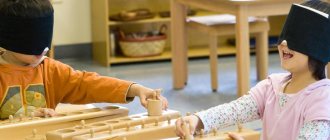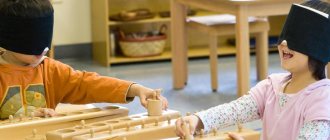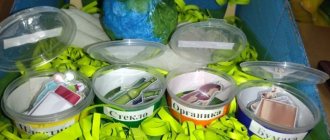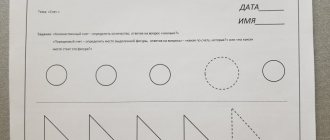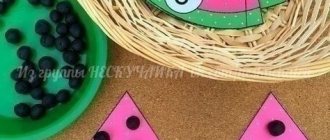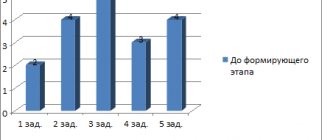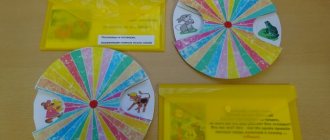DIY: Games and Tools for Sensory Education for Children
Nadezhda Ryazanova
DIY: Games and Tools for Sensory Education for Children
I bring to your attention a selection of games and aids for the sensorimotor development of children that I use in my work. If desired, they can be easily made with your own hands.
Games using hair ties.
1. Game “Palms”:
The game develops fine motor skills, reaction speed, attention, visual perception, the ability to count and distinguish colors.
To play you need 32 cards with tasks, rubber bands (6 colors of 12 pieces each, a bell.
Number of players from 2 to 6. Age from 4 years.
For those who are not yet familiar with this game, I will write its rules: the bell is placed in the center of the table so that each player can easily reach it. Rubber bands are located around the bell, the cards are face down.
The first player turns over one card and places it so that everyone can clearly see it. Players try to match the color of the rubber bands as quickly as possible and put them on their fingers, as shown on the card. The one who completes the task first rings the bell. The remaining players check whether the task was completed correctly. If the player did everything correctly, he takes the card for himself. If he makes a mistake, he misses his turn. The first one to collect 5 cards wins.
Game option: the map with the task opens only for 5 seconds. Then it turns over and the players complete the task from memory.
2. Game “Colored Columns”:
The manual consists of colored columns attached to a board and hair bands. Rubber bands can differ not only in color, but also in shades of the same color. The manual can be used in children’s independent activities, as well as in individual work with children (joint activity of the teacher and the child)
1. For younger preschoolers.
Objectives: to form ideas about color, develop fine motor skills.
Assignment: put an elastic band on a post of the corresponding color.
2. For older people.
Objectives: to form ideas about shades of color, practice counting, consolidate spatial concepts.
Additional equipment - cards with numbers or dots.
The child puts as many rubber bands on the post as there are dots on the card (one more, one less, etc.)
Or: put three elastic bands on the left column, one more on the middle and right columns. There can be as many options as you can think of, depending on the age of the children and learning objectives.
Games using pebbles, beans, pasta, buttons, counting sticks.
All presented games and manuals can be used, starting from early preschool age, in joint activities with the teacher.
Objectives: develop tactile sensations, form ideas about the shape of an object, size, position in space; learn to analyze, find similarities and differences.
Game “Find two identical bags”:
Identical bags are filled in pairs with different fillings: balls, beads, rustling packaging, construction kit parts, etc. Children look for two identical bags by touch.
Tutorial using buttons “Numbers and geometric shapes”
Helps memorize the image of a number and develop the ability to distinguish between numbers and geometric shapes.
Game "Guess by touch"
The child determines by touch which number or geometric figure is “hidden” in the bag.
Game “Following the example”:
The child is offered a sample according to which he completes the task (lays out sticks or writes a pattern, number, letter, geometric figure on semolina).
These cards are tasks that can be used for playing with sticks; they contribute to the development of spatial-imaginative thinking.
Game "Sorter":
The child sorts pasta or pebbles or buttons according to a certain characteristic (by color, size, shape, etc.)
Game "Tic Tac Toe":
For children of senior preschool age.
A set of objects for the development of tactile sensations.
With younger children we examine, examine objects by touch, and talk about sensations. Next we play the game “Wonderful Bag”.
Manual “Sensory Umbrella”:
Clothespins, ribbons of different lengths, widths, colors, and laces are used. Laces for learning to braid, ribbons for fastening colors and shades, for teaching children the ability to find identical ribbons in length and width, the ability to compare, find common features and differences.
Manual "Shoe".
In addition to the tasks listed above, children learn to lace shoes and tie a bow.
Example of a task: lace up your shoe with the longest lace and tie the bow with the shortest ribbon.
Games for hearing development.
a) using jars with different fillings
b) using bells and rattles.
Task: find two objects that sound the same.
Games for consolidating counting, numbers and the alphabet:
On such cards you can write numbers in fives, in pairs, up to 50, up to 100, you can write the alphabet, you can only write vowels.
We place the card in a plastic folder or laminate it, the child uses a felt-tip pen to connect the numbers or letters in order and fill in the missing ones.
Games using a math tablet:
Objectives: develop tactile sensations, fine motor skills; fix color, shape; determine the spatial relationships of parts relative to each other (left, right, above, below, etc.).
You can draw sticks, objects, numbers, letters, labyrinths, corners according to the model and design.
You can also use a variety of task cards.
Games that develop the ability to compare and find common features:
“Octopuses”, “Owls”, Find the animal” (find the animal using the fragment).
Games that form spatial concepts, the ability to navigate on a sheet of paper, the ability to complete a task according to the example:
"Repeat the pattern":
The child traces the outline with a felt-tip pen or plasticine flagella or lays it out with beans.
There are two more manuals that are constantly updated: “Weight Jars” and “Jars with Smells.”
Sources used: blog of Natalia Chistokletova.
Lesson objectives
Sensory development through didactic games has the following features:
- teaches you to perceive the world around you through all your senses;
- forms a system of basic actions that are a reaction to external stimuli;
- teaches you to explore the world around you;
- forms a system of sensory patterns;
- teaches you to independently apply sensory patterns depending on the situation.
The child learns about the world around him through sensations. Therefore, the ability to perceive all channels of information, not limit one’s own feelings and interpret them correctly will be useful for children’s development. Sensory culture is the key to comprehensive development, successful activity, and the formation of a thinking personality that strives to understand the world around us.
Note! Also, without sensory development, it will not be possible to teach a child to understand art and find beauty in it.
The concept of sensory
“The child’s mind is at the tips of his fingers” - the words of the Soviet teacher V. Sukhomlinsky accurately reflect the tasks of raising a preschooler. In early childhood (from 1 to 3 years), development occurs through objective activity, in which imaginative thinking is formed. It is important for children to taste an object, feel its structure, and touch the surface. By interacting with surrounding objects, the child learns to perceive and analyze information. The senses and corresponding analyzers help him in this:
Through these systems, ideas about the surrounding reality are formed, which are enshrined in sensory standards - generally accepted properties of objects. Such standards are shapes, colors, size, taste, sound level, temperature.
The sensory system of a preschooler includes two interconnected aspects:
- Mastering ideas about the properties and relationships of objects. The child is looking for new ways to interact with previously unknown objects.
- Mastering new perceptual actions that allow you to more fully perceive the world around you. The child can perform operations not with objects, but with symbols, and becomes able to solve simple problems in his mind, without resorting to trial and error.
Sensory development allows:
- enrich your vocabulary;
- form the correct structure of speech;
- improve cognitive mental processes: memory, attention, thinking, perception;
- develop imagination;
- obtain complete information about the surrounding reality;
- improve communication skills.
A child who has a developed system of perception and processing of information is able to navigate perfectly in the conditions of the modern world.
Card index: sensory games for the middle group
It is assumed that children already have basic knowledge of shape, color and size. Therefore, sensory classes in the middle group can require a lot of time, and can also be combined, that is, aimed at developing several skills at once.
Note! The same games can be used in the older group.
"Coins"
Goal: to consolidate knowledge about the circle, to teach how to determine the size of objects by eye.
Materials: paper cups with holes in the bottom, coins of different sizes.
Procedure: first, the teacher cuts out a circle at the bottom of each cup that would correspond to one coin. The child matches objects with prepared holes. The teacher makes sure that smaller coins do not fit into the larger holes.
Other forms can also be correlated
"Cinderella"
Goal: development of fine motor skills of the hands.
Materials: various cereals (rice, buckwheat, peas).
Procedure: a small amount of all the cereals is poured onto a plate, and the children must sort them into cups at speed.
Didactic games can be of great help to the teacher in the process of children's sensory development.
Note! It is important to be able to choose the right material that would reflect the program objectives.
Also, we must not forget about the principle of moving from simple to complex and regular repetition. Every child in the kindergarten must actively participate in the process, and the game itself, at any level of difficulty, must maintain a dynamic pace.
Editor: Elizaveta Sergeevna Koneva
Primary school teacher of the first qualification category, defectologist.
